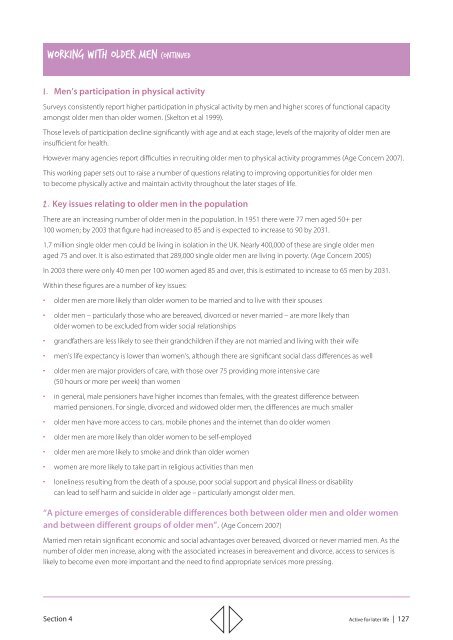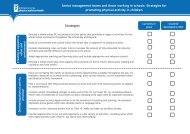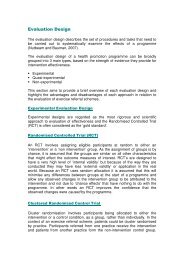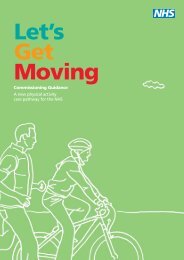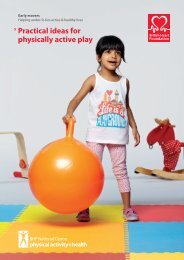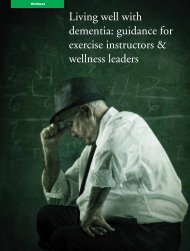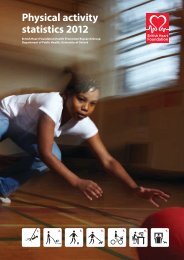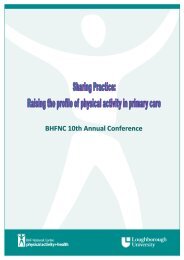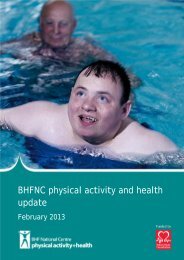Working papers - BHF National Centre - physical activity + health
Working papers - BHF National Centre - physical activity + health
Working papers - BHF National Centre - physical activity + health
You also want an ePaper? Increase the reach of your titles
YUMPU automatically turns print PDFs into web optimized ePapers that Google loves.
<strong>Working</strong> with older men CONTINUED<br />
1. Men’s participation in <strong>physical</strong> <strong>activity</strong><br />
Surveys consistently report higher participation in <strong>physical</strong> <strong>activity</strong> by men and higher scores of functional capacity<br />
amongst older men than older women. (Skelton et al 1999).<br />
Those levels of participation decline significantly with age and at each stage, levels of the majority of older men are<br />
insufficient for <strong>health</strong>.<br />
However many agencies report difficulties in recruiting older men to <strong>physical</strong> <strong>activity</strong> programmes (Age Concern 2007).<br />
This working paper sets out to raise a number of questions relating to improving opportunities for older men<br />
to become <strong>physical</strong>ly active and maintain <strong>activity</strong> throughout the later stages of life.<br />
2. Key issues relating to older men in the population<br />
There are an increasing number of older men in the population. In 1951 there were 77 men aged 50+ per<br />
100 women; by 2003 that figure had increased to 85 and is expected to increase to 90 by 2031.<br />
1.7 million single older men could be living in isolation in the UK. Nearly 400,000 of these are single older men<br />
aged 75 and over. It is also estimated that 289,000 single older men are living in poverty. (Age Concern 2005)<br />
In 2003 there were only 40 men per 100 women aged 85 and over, this is estimated to increase to 65 men by 2031.<br />
Within these figures are a number of key issues:<br />
• older men are more likely than older women to be married and to live with their spouses<br />
• older men – particularly those who are bereaved, divorced or never married – are more likely than<br />
older women to be excluded from wider social relationships<br />
• grandfathers are less likely to see their grandchildren if they are not married and living with their wife<br />
• men’s life expectancy is lower than women’s, although there are significant social class differences as well<br />
• older men are major providers of care, with those over 75 providing more intensive care<br />
(50 hours or more per week) than women<br />
• in general, male pensioners have higher incomes than females, with the greatest difference between<br />
married pensioners. For single, divorced and widowed older men, the differences are much smaller<br />
• older men have more access to cars, mobile phones and the internet than do older women<br />
• older men are more likely than older women to be self-employed<br />
• older men are more likely to smoke and drink than older women<br />
• women are more likely to take part in religious activities than men<br />
• loneliness resulting from the death of a spouse, poor social support and <strong>physical</strong> illness or disability<br />
can lead to self harm and suicide in older age – particularly amongst older men.<br />
“A picture emerges of considerable differences both between older men and older women<br />
and between different groups of older men”. (Age Concern 2007)<br />
Married men retain significant economic and social advantages over bereaved, divorced or never married men. As the<br />
number of older men increase, along with the associated increases in bereavement and divorce, access to services is<br />
likely to become even more important and the need to find appropriate services more pressing.<br />
Section 4 Active for later life | 127


